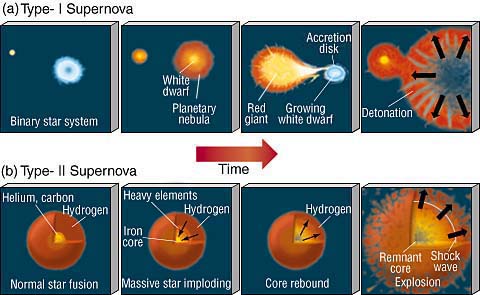GCSE ASTRONOMY -TOPIC 3
0.0(0)
Card Sorting
1/104
There's no tags or description
Looks like no tags are added yet.
Study Analytics
Name | Mastery | Learn | Test | Matching | Spaced |
|---|
No study sessions yet.
105 Terms
1
New cards
Describe the appearance of stars in the night sky.
Stars appear as points of light when seen in binoculars and telescopes.
2
New cards
What is a double star? Provide an example of an optical double.
Binary stars are a pair of stars that interact gravitationally because they are very close to each other, whereas two stars in a close line of sight are known as optical doubles.
Alcor and Mizar in the Plough are an optical double (\~ 3 l.y. apart).
Alcor and Mizar in the Plough are an optical double (\~ 3 l.y. apart).
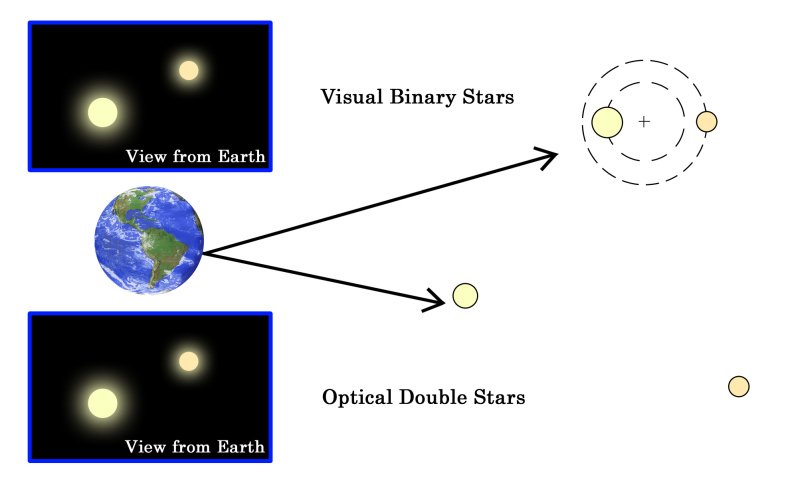
3
New cards
What is an asterism? Provide an example.
Smaller groups of stars than constellations that form familiar shapes.
\
e.g. the Plough (in Ursa Major), the Great Square of Pegasus, and the Summer Triangle.
\
e.g. the Plough (in Ursa Major), the Great Square of Pegasus, and the Summer Triangle.
4
New cards
What is a constellation?
An area of sky containing a pattern of stars.
5
New cards
Describe the appearance of an open cluster and state an example.
Loose groups of fairly bright stars that can be seen well using binoculars. The stars are not tightly packed but are an impressive sight.
The most easily seen open cluster in the night sky is the Pleiades (M45, the Seven Sisters).
The most easily seen open cluster in the night sky is the Pleiades (M45, the Seven Sisters).
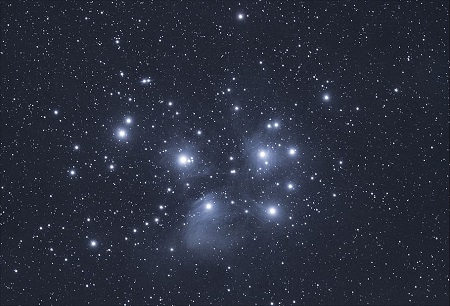
6
New cards
Describe the appearance of nebulae.
Faint fuzzy patches of light (Latin for cloud, singular: nebula).
An example would be the Great Nebula in Orion (M42 and M43).
An example would be the Great Nebula in Orion (M42 and M43).

7
New cards
Describe the appearance of globular clusters.
Globular clusters appear as fuzzy, circular patches of light in binoculars. In telescopes, more of the stars towards the centre of the cluster can be identified.
An example would be the Great Globular Cluster in Hercules (M13).
An example would be the Great Globular Cluster in Hercules (M13).
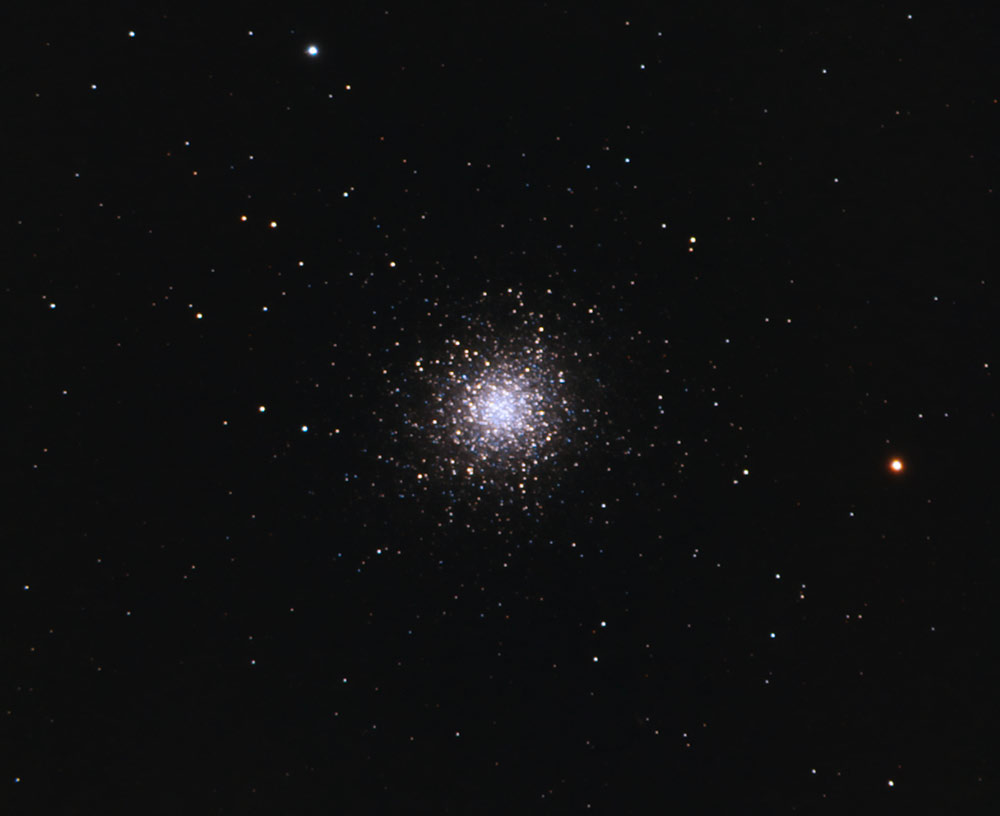
8
New cards
Explain the Beyer system of labelling stars in a constellation according to brightness.
**Stars in a constellation are labeled with Greek letters α, β, γ, δ, ε... according to how bright they appear**; in this scheme @@α is the brightest@@, β the second and so on.
To complete the labelling, the Greek letter is followed by a shortened three-letter version of the genitive case of the constellation’s name.
To complete the labelling, the Greek letter is followed by a shortened three-letter version of the genitive case of the constellation’s name.

9
New cards

What was the earliest list of constellations published?
Published around the year 150 CE by the Egyptian astronomer and geographer Ptolemy.
10
New cards
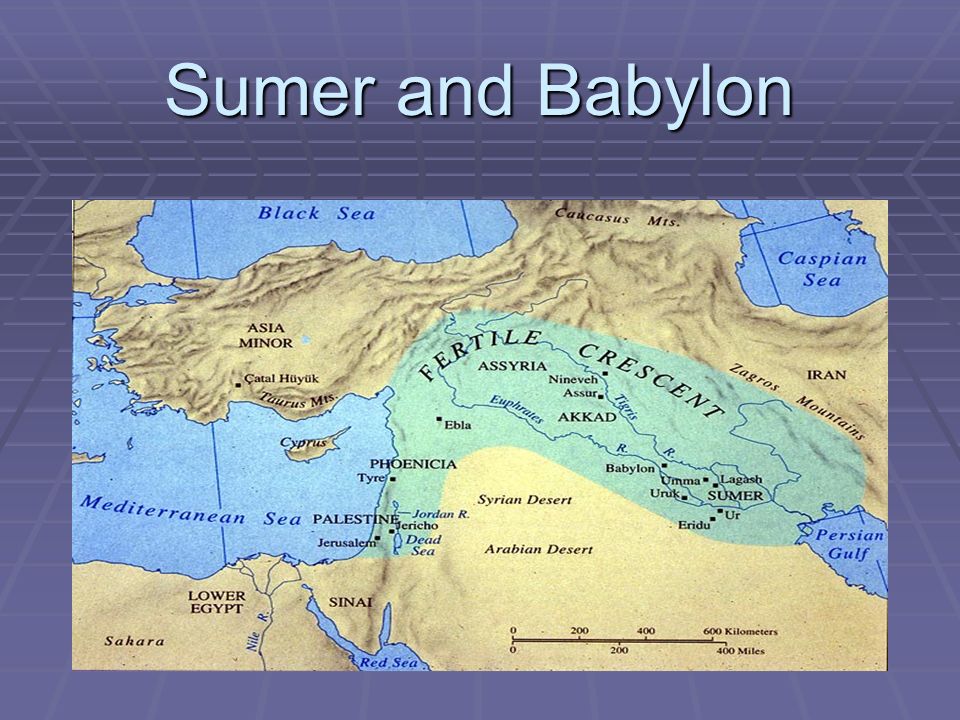
What are the probable origins of the names of the original constellations?
Probably devised at the dawn of written history (\~ 2000 BCE) by early Babylonian and Sumerians
11
New cards
Where do the names of the constellations come from?
* named after **heroes and heroines** from legends and mythological stories (e.g. Hercules, Perseus and Andromeda)
* real and **fabled creatures** (such as Scorpius, Taurus and Pegasus).
* real and **fabled creatures** (such as Scorpius, Taurus and Pegasus).
12
New cards

How many official constellations do we currently acknowledge?
88
13
New cards

Describe how ancient Chinese astronomers used different patterns of stars.
They divided their sky into:
* **31 regions** comprising
* **3 Enclosures** (close to north celestial pole)
* and **28 Mansions** (covering the zodiacal region).
* **31 regions** comprising
* **3 Enclosures** (close to north celestial pole)
* and **28 Mansions** (covering the zodiacal region).
14
New cards
Draw the Plough.
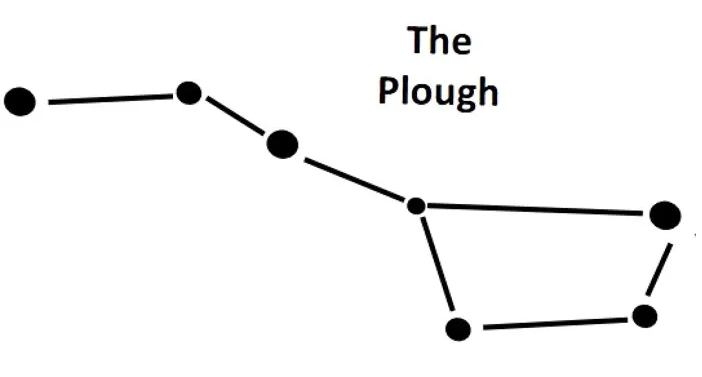
15
New cards
Draw Orion.
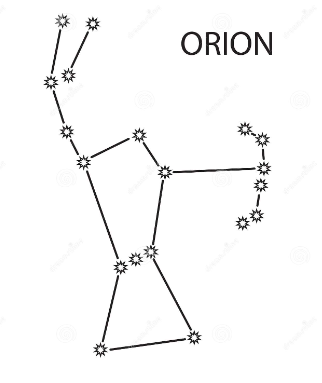
16
New cards
Draw Cygnus.

17
New cards
Draw Cassiopeia.

18
New cards
What is a pointer?
Pointers are used by astronomers to guide people to new regions of the night sky.
19
New cards
Describe how pointers are used to identify Arcturus and Polaris.
* Following a line up from the two stars furthest right in the Plough leads to **Polaris** (the Pole Star, α UMi),
* whilst 'following the arc' of the handle leads to **Arcturus** (α Boo).
@@**see diagram**@@
* whilst 'following the arc' of the handle leads to **Arcturus** (α Boo).
@@**see diagram**@@
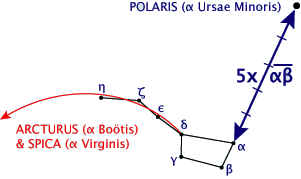
20
New cards
Describe how pointers are used to identify Sirius, Aldebaran and the Pleiades.
* Follow the line of Orion's Belt - up to the right is found the bright red star **Aldebaran**;
* down to the left is **Sirius**, the brightest star in the night sky.
* The **Pleiades**, an open cluster is found beyond Aldebaran.
@@**see diagram**@@
* down to the left is **Sirius**, the brightest star in the night sky.
* The **Pleiades**, an open cluster is found beyond Aldebaran.
@@**see diagram**@@
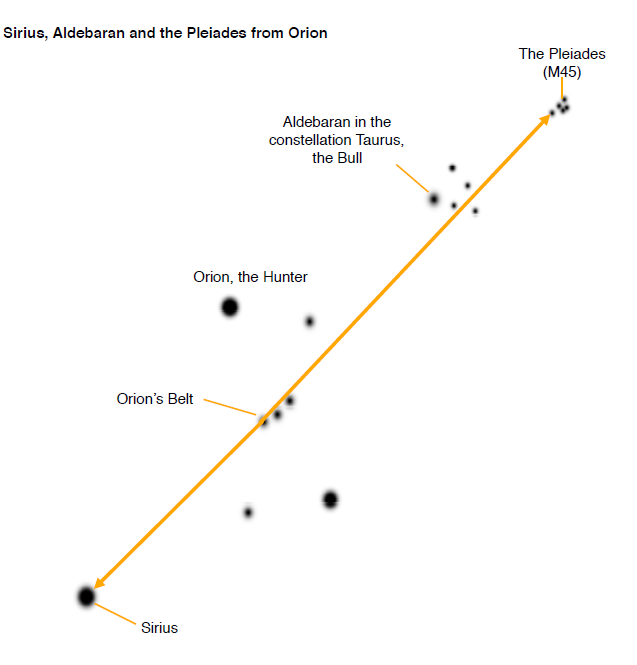
21
New cards
Describe how pointers are used to identify Fomalhaut and the Andromeda Galaxy.
Using the asterism the Great Square of Pegasus:
1. follow the line of the top two stars of the squareleft to find M31;
2. follow the two furthest right downwards to find Fomalhaut in the Southern Fish constellation.
@@**see diagram**@@
1. follow the line of the top two stars of the squareleft to find M31;
2. follow the two furthest right downwards to find Fomalhaut in the Southern Fish constellation.
@@**see diagram**@@
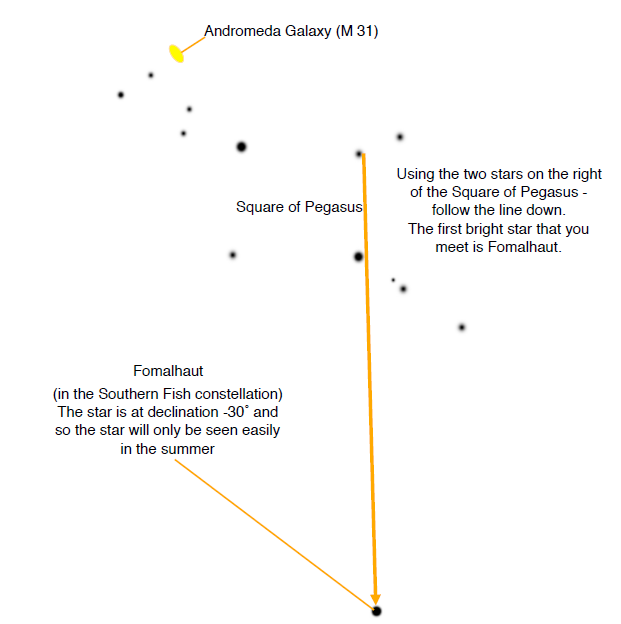
22
New cards
Name three constellations visible from the UK all year long.
1. Ursa Major
2. Ursa Minor
3. Cassiopeia
23
New cards
Name two constellations that are seasonal (only visible from a given location for a few months of the year).
* Orion
* Gemini
* Gemini
24
New cards
Why are some constellations seasonal?
Because of the Earth's orbital motion around the Sun, and the fact that stars cannot be seen during the day.
25
New cards
What is the celestial sphere?
An imaginary sphere surrounding the Earth, whose centre is the same as that of the Earth.
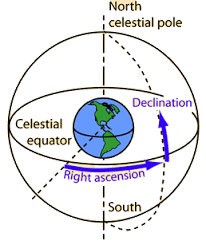
26
New cards
What is a meant by the term declination (dec)?
* The angular distance of a celestial body north or south of the celestial equator.
* Expressed as an angle,
* with **+** depicting north and **-** depicting south of the celestial equator (zero declination).
* Expressed as an angle,
* with **+** depicting north and **-** depicting south of the celestial equator (zero declination).
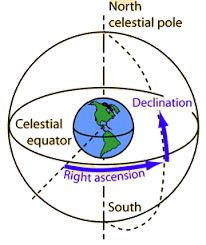
27
New cards
What is meant by the term right ascension (RA)?
* The angular distance of a star from the vernal equinox, measured westward.
* It is the interval between the transit of the vernal equinox and the transit of the body concerned.
* It is the interval between the transit of the vernal equinox and the transit of the body concerned.
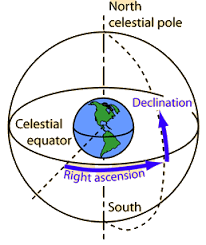
28
New cards
When is the Vernal (Spring) Equinox?
**~ March 21st**
29
New cards
What units is right ascension measured in?
Units of time (hours and minutes, where 1 hour is equivalent to 15 degrees) eastward (to the left on a star chart).
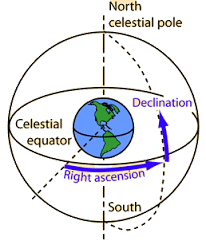
30
New cards
What are the celestial coordinates and dates for the times of the year when the Sun is at its maximum declination?
* Maximum declinations of **+23.5° and -23.5°**
* at **RAs of 6 h and 18 h**
* (on or near **June 21st** and **December 21st** respectively, the summer and winter solstices).
* at **RAs of 6 h and 18 h**
* (on or near **June 21st** and **December 21st** respectively, the summer and winter solstices).
31
New cards
What is the Zodiacal Band?
It straddles the ecliptic by \~ 8 degrees on either side.
This is the part of the sky that contains the constellations of the zodiac and is the region in which planets and the Moon are located.
This is the part of the sky that contains the constellations of the zodiac and is the region in which planets and the Moon are located.

32
New cards
What is the declination of Polaris (α UMi)?
**~ +90°**
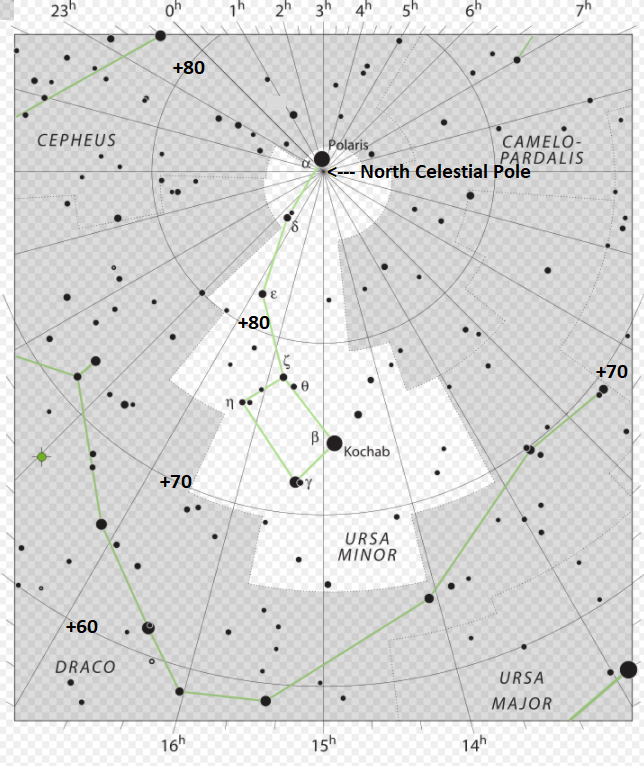
33
New cards
How can we use Polaris to determine latitude?
The angular elevation of Polaris above the northern horizon is equal to the latitude from where it is observed.
34
New cards
Looking in a northwards direction, which direction do the stars appear to rotate over the course of a night? Why is this?
An anticlockwise sense, due to the Earth's rotation from west to east.
35
New cards
What is meant by a circumpolar star?
A star that never sets from the place of observation.

36
New cards
How can we mathematically work out whether a given star is circumpolar?
A star will be circumpolar from a given latitude on the Earth provided: **declination > 90 - latitude.**
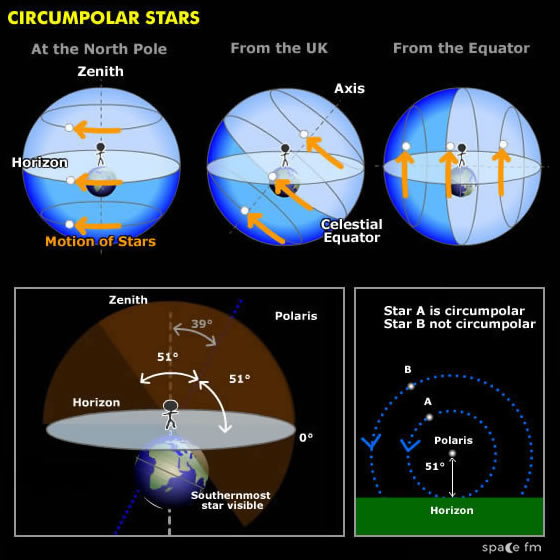
37
New cards
Practically, how do we determine the rotation speed of the Earth using circumpolar stars?
Using long-exposure photography:
* camera should be pointed at Polaris for exposure times of more than 2 hours to give arcs large enough to be measured.
* The image will show a large number of arcs centred on a point very close to Polaris
* the angular distance of a few selected clear arcs can be measured using a protractor.
* camera should be pointed at Polaris for exposure times of more than 2 hours to give arcs large enough to be measured.
* The image will show a large number of arcs centred on a point very close to Polaris
* the angular distance of a few selected clear arcs can be measured using a protractor.
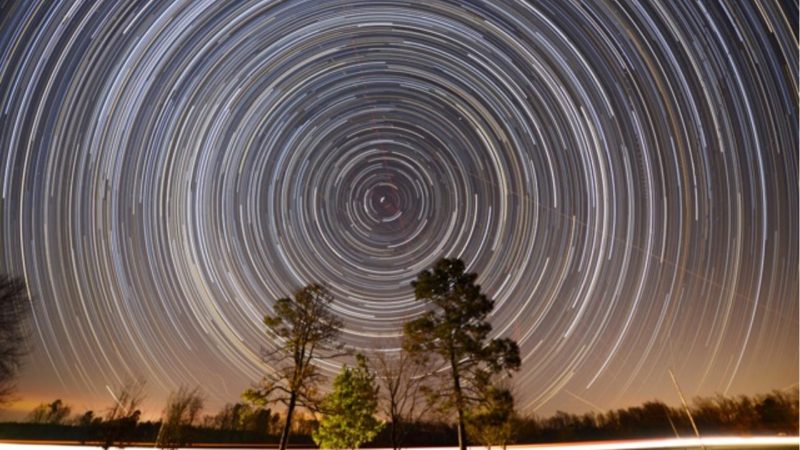
38
New cards
Mathematically, how do we determine the rotation speed of the Earth using circumpolar stars?
Using simple ratios:
rotation period of Earth / exposure time
**= 360° / mean arc angle.**
rotation period of Earth / exposure time
**= 360° / mean arc angle.**
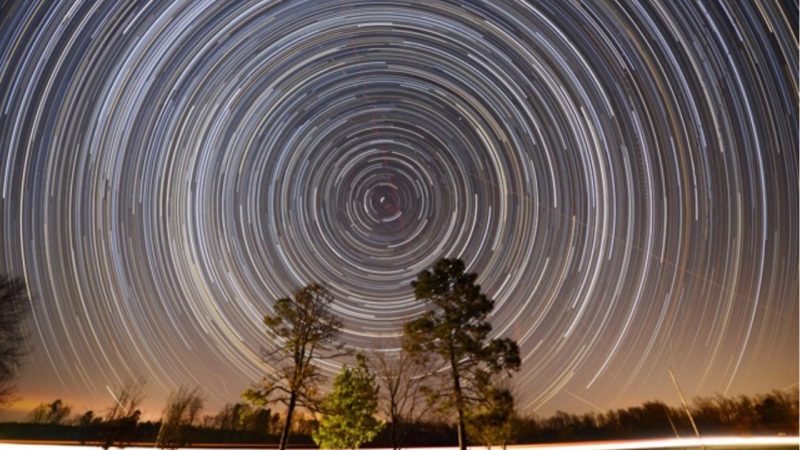
39
New cards
Why is it more difficult to determine the Earth's rotation speed in the southern hemisphere?
Observers in the southern hemisphere **do not have a bright star equivalent to Polaris** above the South Pole and so it will be more difficult to locate the centre of the arcs at which to measure the angles.
40
New cards
What is meant by the term culmination?
The maximum altitude of a celestial body above the horizon.

41
New cards
State three sources of information you could use to plan a stellar observation session?
1. Planisphere,
2. star chart or
3. computer software.
42
New cards
If you have a star of known RA, how do you work out another star's RA?
Subtract the RA from the desired star's RA and you have an angle in hours and minutes.
The equivalent time difference will give the interval of time before the desired star crosses the meridian.
The equivalent time difference will give the interval of time before the desired star crosses the meridian.
43
New cards
Why do stars culminate earlier every day when observed?
* It only takes only 23 h 56 min for a star to return to an observer's meridian (not 24 h),
* which causes the stars to culminate (or rise, or set) **4 min earlier every day**
* (and approximately **2 h earlier every month**).
* which causes the stars to culminate (or rise, or set) **4 min earlier every day**
* (and approximately **2 h earlier every month**).
44
New cards
What points do you need to consider when planning a suitable date for naked-eye observing?
* The phase of the Moon (ideally this should be new - not visible - or at best half-full);
* the weather forecast (clear nights are ideal - even patchy cloud clover will hinder observations significantly);
* the likelihood of meteor shower (perfect for naked-eye observing);
* the visibility of a comet, planets or interesting Messier objects).
* the weather forecast (clear nights are ideal - even patchy cloud clover will hinder observations significantly);
* the likelihood of meteor shower (perfect for naked-eye observing);
* the visibility of a comet, planets or interesting Messier objects).
45
New cards
How do you find out about conditions in advance of commencing a viewing?
* Computer software such as Stellarium,
* a planisphere or star charts such as those published in magazines.
* a planisphere or star charts such as those published in magazines.
46
New cards
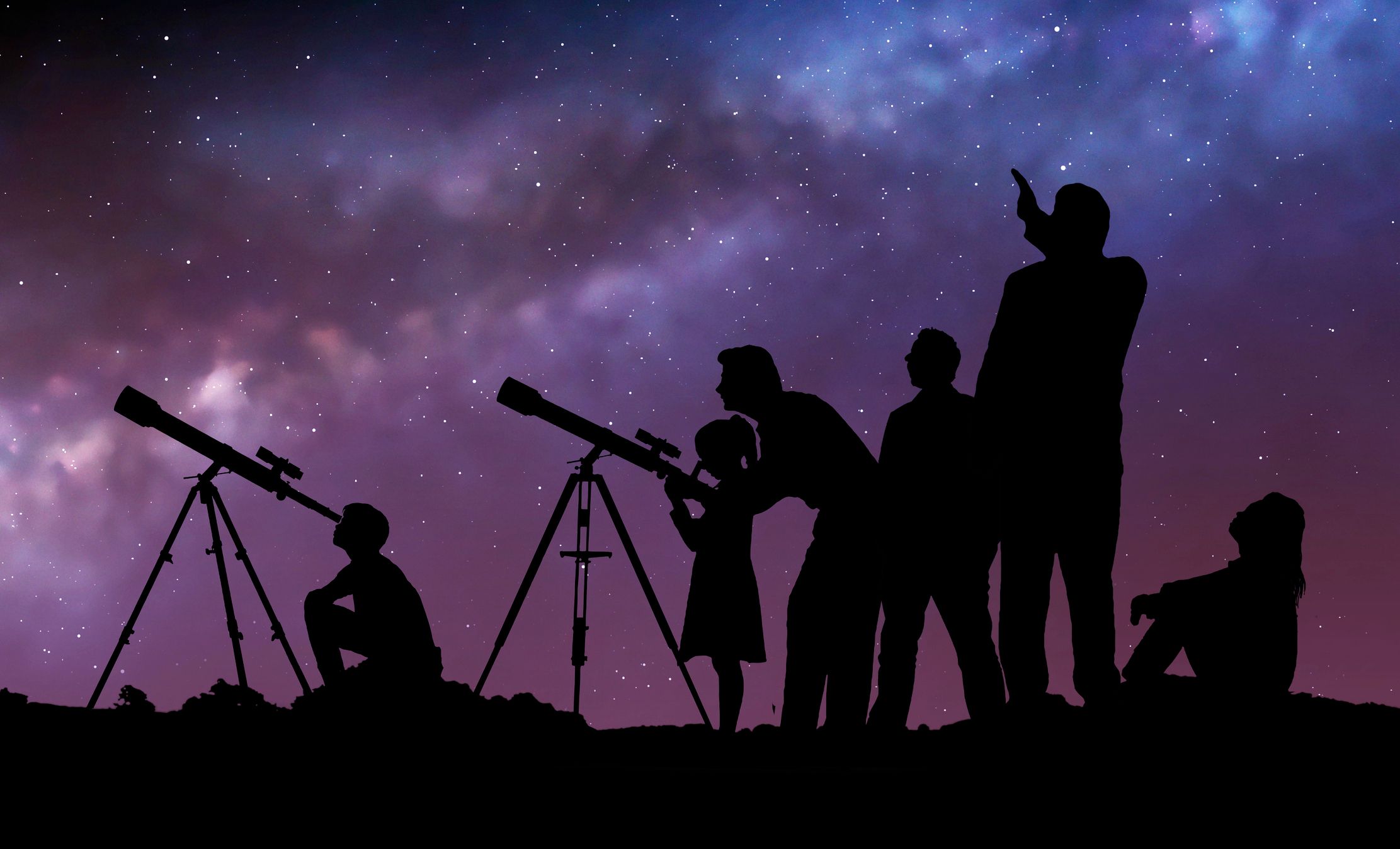
What equipment would you use to undertake a naked-eye observation?
* Comfortable reclining chair with small table;
* head torch with red filter;
* clipboard,
* prepared star chart with pen/pencil and rubber;
* warm clothes and
* refreshments.
* head torch with red filter;
* clipboard,
* prepared star chart with pen/pencil and rubber;
* warm clothes and
* refreshments.
47
New cards
What are the two types of light-sensitive cells present in the retina of the eye?
* **Rods**
* and **cones** (colour-sensitive).
* and **cones** (colour-sensitive).
48
New cards
Why must the eyes be dark-adapted before serious observing can take place? How can you aid this process?
* 20-30 min of darkness allows the retina's rods to become fully light-sensitive.
* The use of a red light to illuminate sketches and diagrams will not have an adverse effect on dark-adapted eyes.
* The use of a red light to illuminate sketches and diagrams will not have an adverse effect on dark-adapted eyes.
49
New cards
Describe a naked-eye observation technique that allows you to see particularly dim stars or nebulae.
Observers should look slightly to the side of the object (using averted vision) so that the rods are stimulated, allowing the object to be seen.
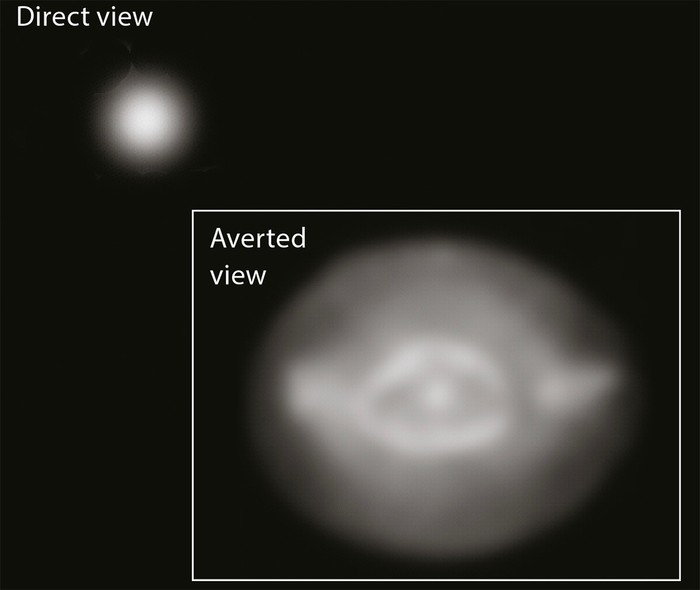
50
New cards

What is the Messier Catalogue?
It contains a list of extended 'fuzzy' objects, many of which are just visible with the naked eye; binoculars or a small telescope can be used to reveal their true splendour.
51
New cards
Who compiled the Messier Catalogue, and what does it contain?
* French astronomer Charles Messier in 1781,
* and contains over 100 fine examples of:
* ==star clusters==, %%nebulae%% and ^^galaxies^^.
* and contains over 100 fine examples of:
* ==star clusters==, %%nebulae%% and ^^galaxies^^.
52
New cards
Why did Messier create his Catalogue?
To avoid confusion with comets for which Messier and others were searching for.
53
New cards
Are stars in a constellation physically related? Why is this?
No, it is merely a line-of-sight effect (this does not apply to stars in a cluster, which are linked gravitationally).
54
New cards
What is the difference between an optical double and a binary star?
* **Optical doubles** merely appear to be closely aligned (one star may be many times further away than the other),
* Stars in a **binary system** are the same distance from us and orbit their common centre of gravity (mass).
* Stars in a **binary system** are the same distance from us and orbit their common centre of gravity (mass).

55
New cards
What is the apparent magnitude scale of stars?
* The observed brightness of a star is measured in magnitudes
* a difference of exactly 5 magnitudes between two stars corresponds to one star appearing 100 times brighter than the other.
* a difference of exactly 5 magnitudes between two stars corresponds to one star appearing 100 times brighter than the other.
56
New cards
How were stellar magnitudes assigned in ancient times?
* Placed into **6 different magnitude classes**
* those of **1st magnitude were the brightest** since they were visible first after sunset.
* The next brightest were classed as 2nd magnitude
* and so on down to **6th magnitude (the faintest stars visible**).
* those of **1st magnitude were the brightest** since they were visible first after sunset.
* The next brightest were classed as 2nd magnitude
* and so on down to **6th magnitude (the faintest stars visible**).
57
New cards
What does a magnitude difference of 1 correspond to in terms of brightness ratio?
A brightness ratio of the fifth root of 100
(GCSE a value of 2.5 will suffice).
(GCSE a value of 2.5 will suffice).
58
New cards
Convert these magnitude differences to brightness ratios: 1, 2, 3, 4, 5, 6.
2.5, 6.25, 16, 40, 100, 250.
59
New cards
State 4 factors that affect the apparent magnitude of a star **(symbol m)**.
1. The total energy radiated by the star (this depends on the star's size and temperature),
2. the distance of the star,
3. the amount of interstellar gas and dust,
4. the amount of light absorbed by the Earth's atmosphere.

60
New cards
What is the brightest star in the night sky?
**Sirius** magnitude = -1.5, but only because it is one of our closest neighbours.
***Deneb*** *is almost 200 times more distant than Sirius but still appears bright (magnitude = 1.3) because it has an extremely high luminosity.*
***Deneb*** *is almost 200 times more distant than Sirius but still appears bright (magnitude = 1.3) because it has an extremely high luminosity.*
61
New cards
What is the inverse square law of light intensity?
* If the distance of a star doubles, the star will appear four times dimmer;
* if the distance increases by a factor of 5, the star appears dimmer by a factor of 25
* if the distance increases by a factor of 5, the star appears dimmer by a factor of 25
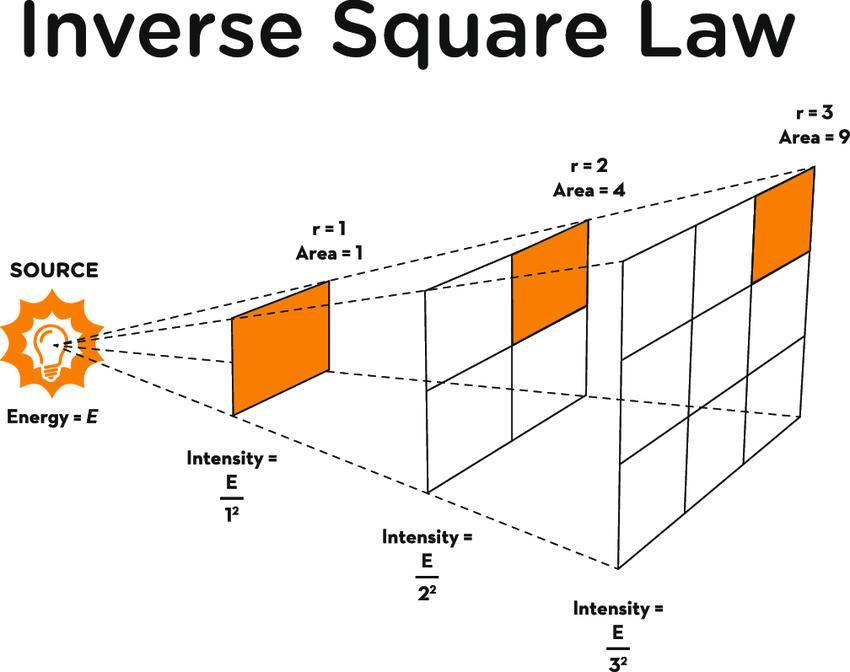
62
New cards
Define the absolute magnitude of a star **(symbol: M)**.
A measure of the true brightness of a star, defined as the **apparent magnitude the star would have if it was observed from a standard distance of 10 parsecs**.
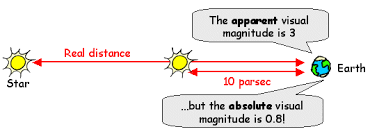
63
New cards
Mathematically, how are the apparent (**m**) and absolute magnitudes (**M**) of stars related?
Using the distance modulus formula: ==**M = m + 5 - 5logd**==
\
Where d is the distance to the star in pc.
\
Where d is the distance to the star in pc.
64
New cards
What is a variable star?
stars that vary in intensity on a regular basis
65
New cards
What are the two types of variable star?
1. Binary stars
2. Cepheid variables.
66
New cards
What is a Cepheid variable?
Giant yellow stars that regularly expand and contract in size (named after the prototype δ Cep).
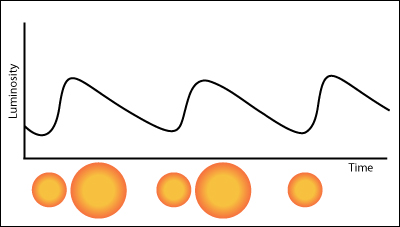
67
New cards
What do we call a graph showing how light intensity from a variable star changes over time? How can we determine the period of variability?
**Light curves**. Period of variability determined by simply reading off the time axis.
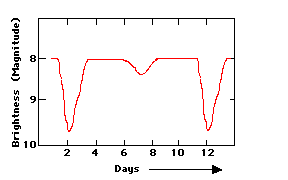
68
New cards
What do we call the two stars in a binary system?
The ==brighter star is called the **primary star**==, the ^^dimmer star is called the **companion** or **secondary star**^^.
69
New cards
What do we call it if the stars orbit in a plane along our line of sight?
Because the two stars will eclipse one another, we call it an **eclipsing binary**.
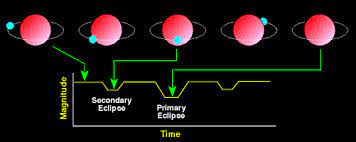
70
New cards
Name an example of a well-known eclipsing binary.
Algol (β Per).
71
New cards
Why does the intensity of light from a binary star vary?
Because of stellar motion (the stars are orbiting one another).

72
New cards
Why does the intensity of light from a Cepheid variable vary?
Because the star expands and contracts, hence the size and temperature of the star have a dramatic effect on its intensity.
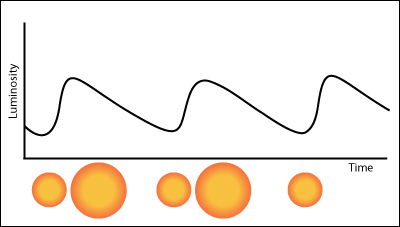
73
New cards
Why can astronomers not use radar to establish stellar distances?
* Stars are so far away that the time taken for the 'return' signal would be in years, even for the nearest stars
* any such reflected signal would be so weak that it would be undetectable from background noise.
* any such reflected signal would be so weak that it would be undetectable from background noise.
74
New cards
What is parallax?
The apparent motion of near and more distant objects with respect to one another (caused by the motion of the observer).

75
New cards
Describe the method of heliocentric parallax to determine distances to nearby stars.
If the (very small) angular shift in position of a nearby star over a period of 6 months can be measured to determine its distance.
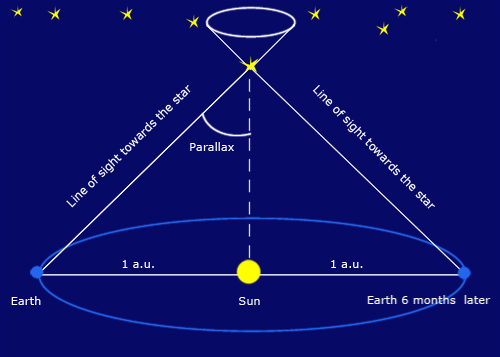
76
New cards
\
77
New cards
where d is in parsec and p is in seconds of arc (parsec).

78
New cards
What is the definition of a parsec?
One parsec is the distance at which a star would have a parallax angle of one arcsec. (NB. 1 degree is 60 minutes of arc, and 1 minute is 60 seconds of arc, so 1 arcsec in 1/3600 of a degree.)

79
New cards

How have Cepheid variables been used to determine stellar distances?
In 1912 Henrietta Leavitt observed a number of these stars in the Small Magellanic Cloud, and established a simple relationship between a star's pulsation period and its mean absolute magnitude.
This period-luminosity law allows us to determine the star's absolute magnitude which, when combined with its apparent magnitude, allows the distance to the star to be calculated using the distance modulus formula.
This period-luminosity law allows us to determine the star's absolute magnitude which, when combined with its apparent magnitude, allows the distance to the star to be calculated using the distance modulus formula.
80
New cards
What is the first stage in star formation?
The **gravitational collapse of huge clouds of gas and dust (nebulae)** that are found mainly in the spiral arms of galaxies. These clouds are \~15 kpc across and may contain enough material to form several thousand stars.
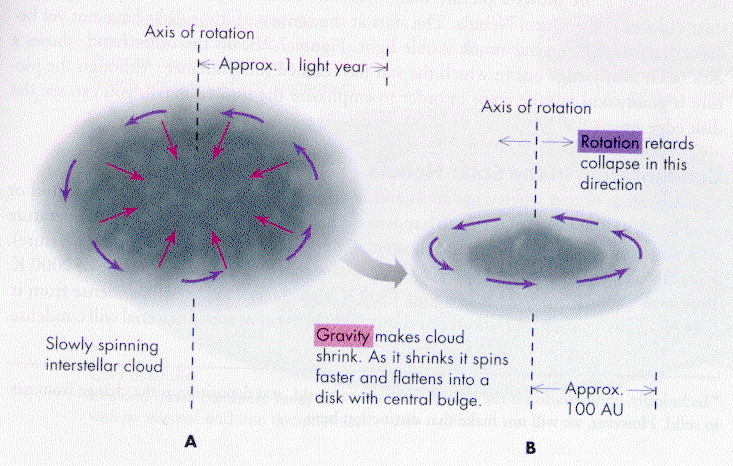
81
New cards
Give a well-known example of a nebula visible with the naked-eye. What type of nebula is this?
The **Orion Nebula.**
This **emission nebula** contains glowing gas that has been excited by newly-formed stars and emits light by fluorescence.
This **emission nebula** contains glowing gas that has been excited by newly-formed stars and emits light by fluorescence.
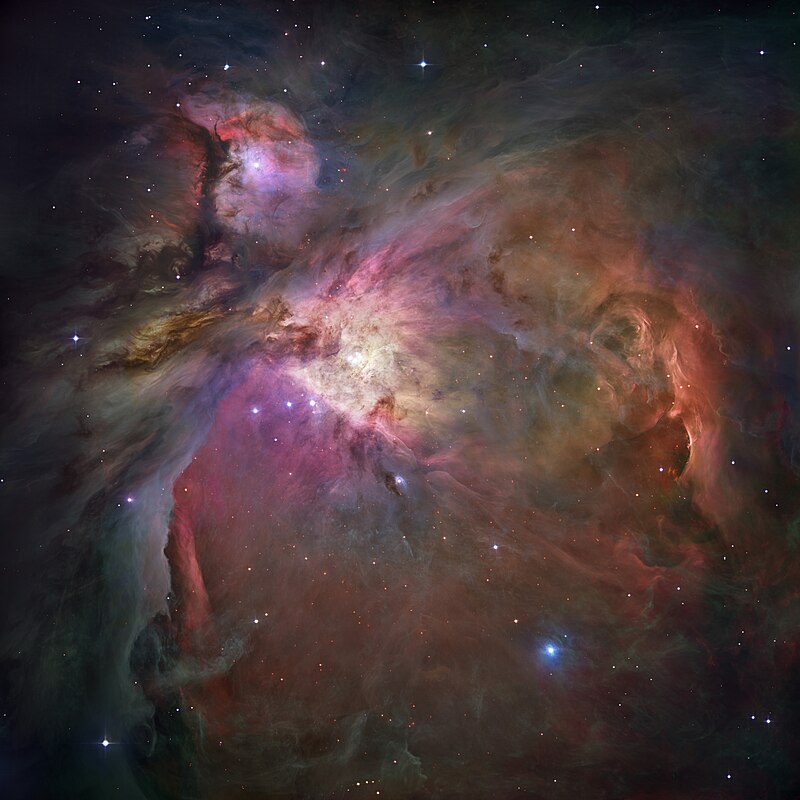
82
New cards
What happens as a nebula begins to collapse?
* Once a gas cloud begins to collapse it can form a **protostar**.
* Eventually, the central temperature of a protostar reaches **15 million K**, hot enough for the **nuclear fusion**
* Eventually, the central temperature of a protostar reaches **15 million K**, hot enough for the **nuclear fusion**
83
New cards
What happens after a protostar begins nuclear fusion?
The ==outward pressure== from the radiation generated in the star's core halts any further ==gravitational== collapse and the star settles to a stable size.
It then begins to radiate energy from its hot surface and becomes a **main sequence star**.
It then begins to radiate energy from its hot surface and becomes a **main sequence star**.
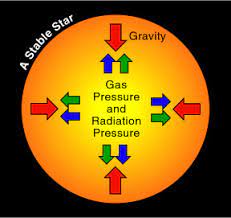
84
New cards
How long does a star remain on the main sequence?
* The main sequence phase of a star is **very stable**,
* **~100 million years (for a large mass** star such as Spica)
* %%\~**1 million million years (for a low mass**%% star such as Barnard's Star) in this state.
* The **Sun is about half way through** its estimated main sequence lifetime of 10 billion years.
* **~100 million years (for a large mass** star such as Spica)
* %%\~**1 million million years (for a low mass**%% star such as Barnard's Star) in this state.
* The **Sun is about half way through** its estimated main sequence lifetime of 10 billion years.
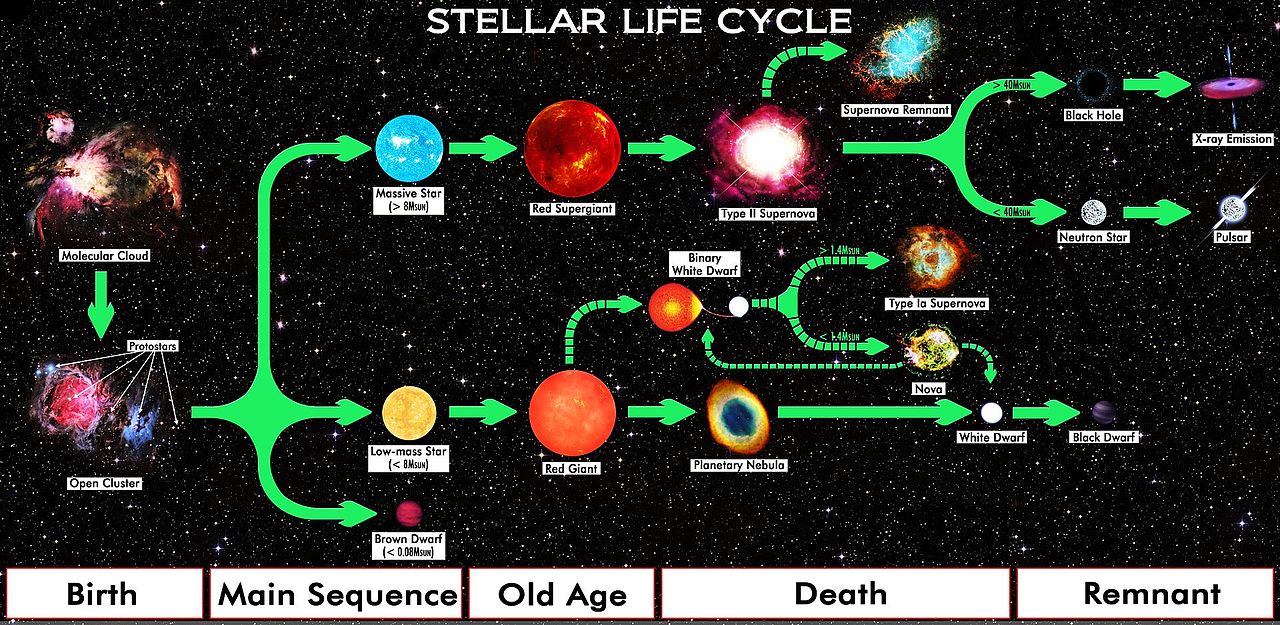
85
New cards
What happens to a star as it leaves the main sequence?
* Eventually, the hydrogen that fuels the star's core runs out.
* The outward radiation pressure is now no longer present, and the star collapses once more under its own gravity.
* This causes a further temperature rise within the star, until hydrogen can undergo fusion in a shell surrounding the core, which is now rich in helium.
* The new nuclear reactions that occur cause the outer layers of the star to expand and cool to form a red giant or supergiant.
* The outward radiation pressure is now no longer present, and the star collapses once more under its own gravity.
* This causes a further temperature rise within the star, until hydrogen can undergo fusion in a shell surrounding the core, which is now rich in helium.
* The new nuclear reactions that occur cause the outer layers of the star to expand and cool to form a red giant or supergiant.

86
New cards

What is the fate of a red giant star?
* the temperature at the centre of a red giant can rise to as hot as 100 million K;
* this is hot enough for helium nuclei to fuse to form carbon.
* When all the helium is depleted the red giant loses its outer layers in an expanding shell of gas (**Planetary Nebula**).
* this is hot enough for helium nuclei to fuse to form carbon.
* When all the helium is depleted the red giant loses its outer layers in an expanding shell of gas (**Planetary Nebula**).

87
New cards
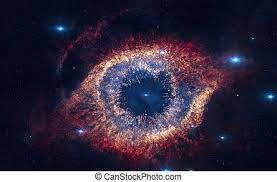
What is a planetary nebula?
The outer layers of a red giant being lost as an expanding shell of gas.
88
New cards
What happens to the core of a red giant?
* The inner part of the star collapses to form a dense, hot **white dwarf** with a mass about the same as the Sun, but with the size of the Earth.
* Eventually, white dwarf stars cool to become red, brown and eventually **black dwarfs**.
* Eventually, white dwarf stars cool to become red, brown and eventually **black dwarfs**.
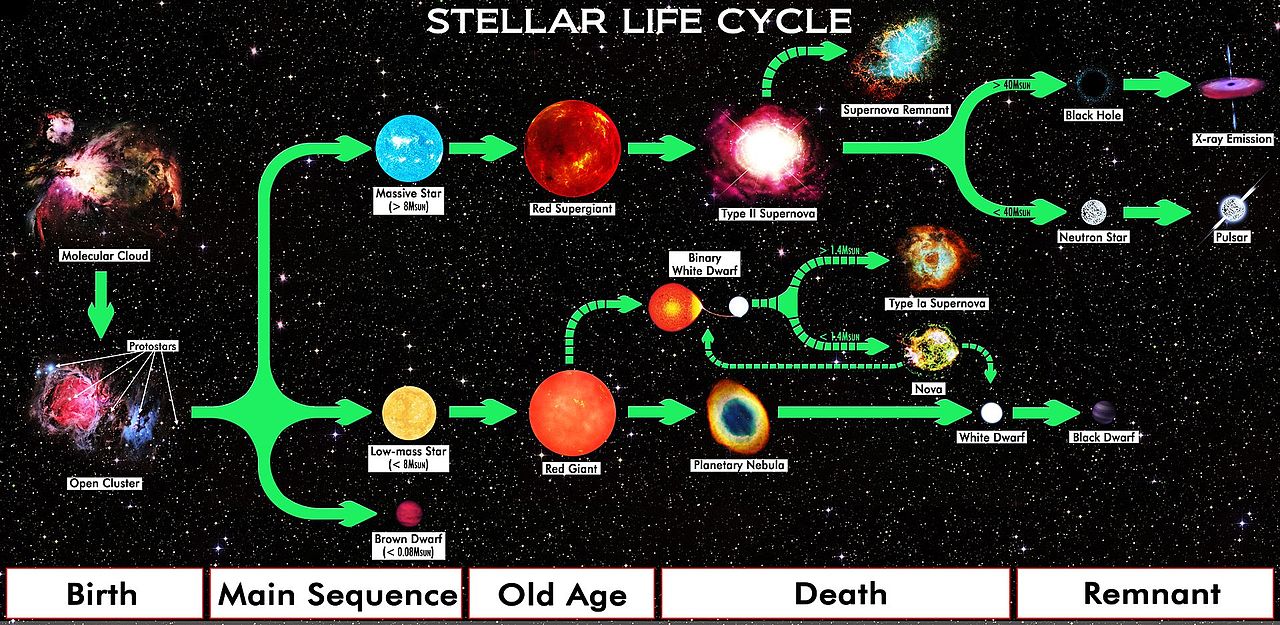
89
New cards
What happens to the core of a red supergiant?
In a larger-mass supergiant star, the temperature of the central core is hot enough for further fusion reactions involving nuclei of elements up to iron occur.
Once these are depleted, a violent explosion (a **supernova**)
Once these are depleted, a violent explosion (a **supernova**)
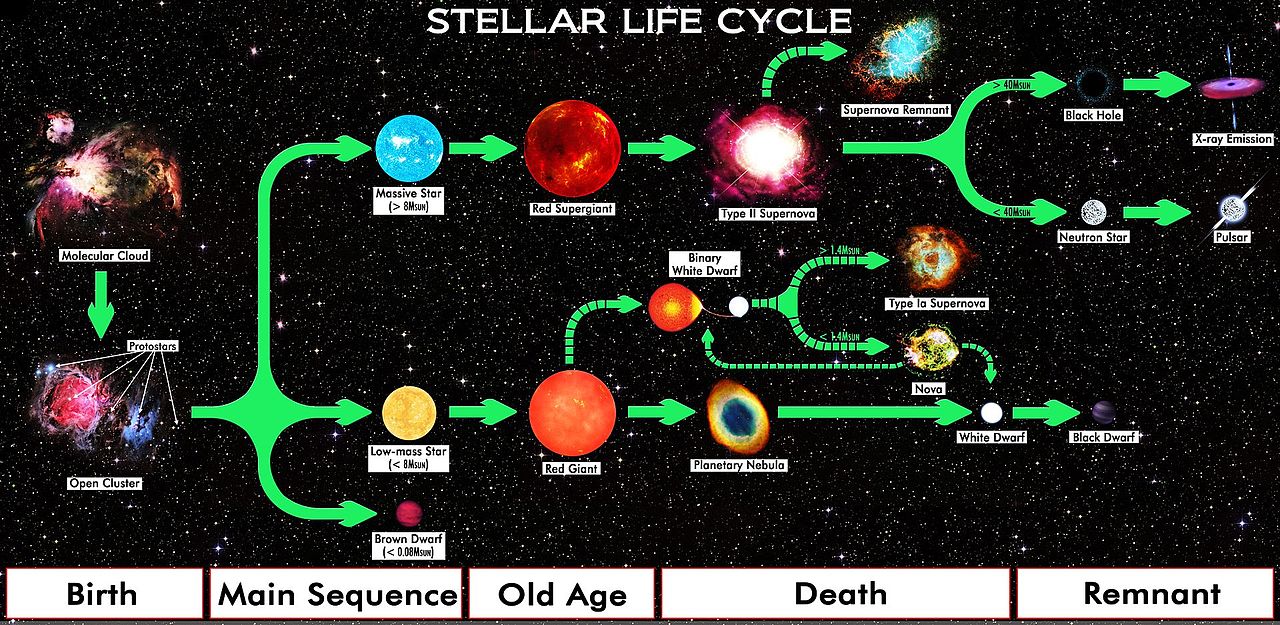
90
New cards
What is a neutron star?
* Neutron stars have masses slightly greater than that of the Sun, but all contained within a **sphere with a diameter of just 20 km**.
* The high densities of neutron stars cause such strong gravitational effects that they are able to **rotate very rapidly on their axes**.
* Rotating neutron stars **emit intense radio waves from their polar regions as they spin**, and these regular short 'pulses' of radio waves enable radio astronomers to detect neutron stars as **pulsars**.
* The high densities of neutron stars cause such strong gravitational effects that they are able to **rotate very rapidly on their axes**.
* Rotating neutron stars **emit intense radio waves from their polar regions as they spin**, and these regular short 'pulses' of radio waves enable radio astronomers to detect neutron stars as **pulsars**.

91
New cards
What information can be derived from a stellar spectrum?
1. Chemical composition,
2. temperature (which in turn determines its colour)
3. radial (in the line of sight) velocity.
92
New cards
What do spectral lines in stellar spectra correspond to?
Known wavelengths of light caused by atoms, ions (and sometimes molecules) in the outer regions of a star absorbing light at well-defined wavelengths.

93
New cards
What is the most common classification system of stars using relative numbers and wavelengths of spectral lines?
The **Harvard scheme** of spectral type that uses the letters ==**OBAFGKM**== (mnemonic: **Oh Be A Fine Girl Kiss Me**).
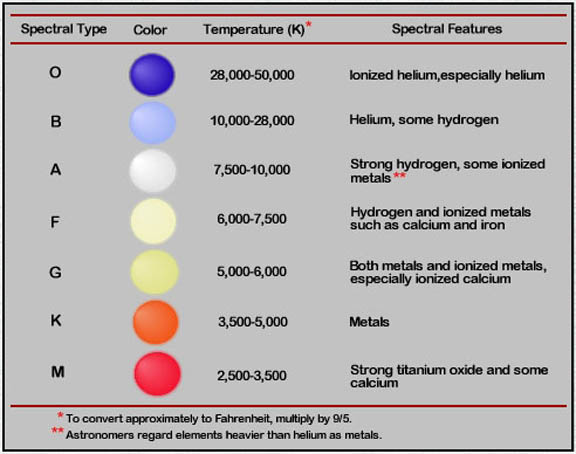
94
New cards
Which is hotter: an O class star or an M class star?
O-type stars are hotter than M-type stars.
\
***High temp*** < **OBAFGKM** > ***Low temp***
\
***High temp*** < **OBAFGKM** > ***Low temp***
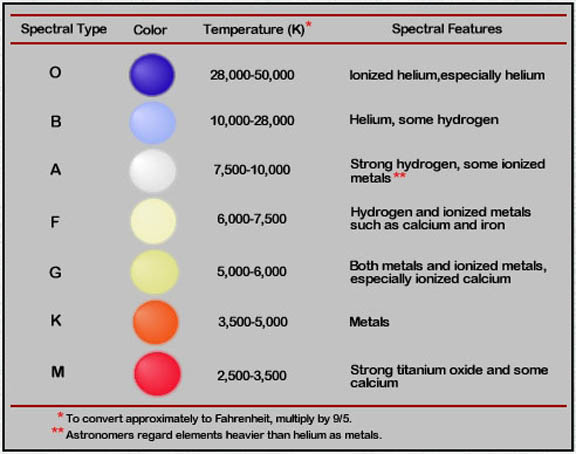
95
New cards
What class of star is our Sun?
A **G2** star (the higher the number, the cooler the star).
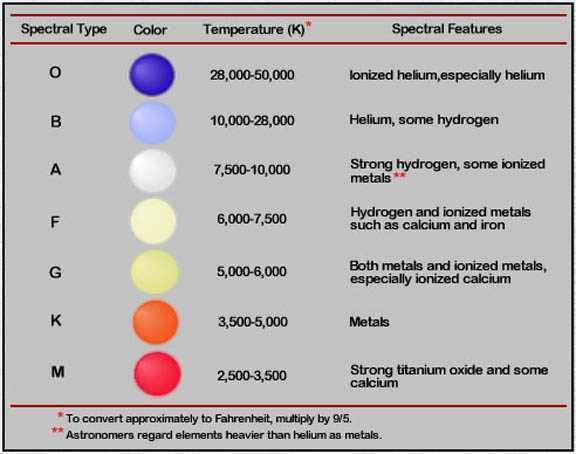
96
New cards
What is the name of the diagram used to represent stellar types? What are the axes?
The **Hertzsprung-Russell** diagram
**Temperature** on the **x-axis** (*temperature increasing right to left*)
**luminosity** on the **y-axis**.
**Temperature** on the **x-axis** (*temperature increasing right to left*)
**luminosity** on the **y-axis**.
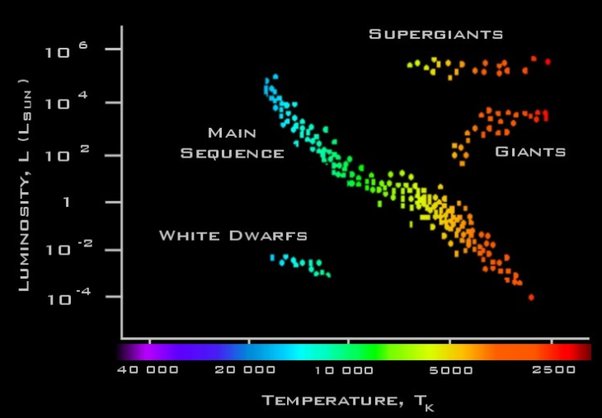
97
New cards
What are the four 'groups' found on an H-R diagram?
1. 'Normal' **main sequence stars** (diagonal band from bottom right to top left),
2. **red giants** (top right),
3. **red supergiants** (slightly to the left of the red giants),
4. **white dwarfs** (bottom left).

98
New cards
Which types of star cannot be represented on an H-R diagram?
* Neutron stars
* black holes
\
***(owing to their small or zero luminosities.)***
* black holes
\
***(owing to their small or zero luminosities.)***
99
New cards
What is a nova?
A nova is a **transient** astronomical event that causes the sudden appearance of a bright, apparently "new" star that slowly fades over weeks or months.
100
New cards
What are the two classes of supervova?
1. **Type I** - formed by the explosion of a white dwarf component of a binary star
2. **Type II** caused by the explosion of stars with a mass of **> 8 solar masses**, after which the core collapses to form a neutron star or a black hole.
